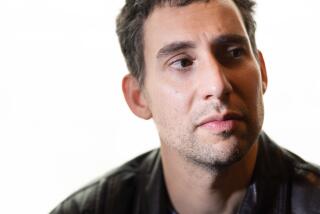TRANSCENDING THE MONK
- Share via
Not many musicians straddle musical worlds as does bassist Buell Neidlinger. He’s probably the only musician to have performed for both Igor Stravinsky and Thelonious Monk.
In the late ‘60s, Neidlinger traveled to Venice, Italy, to play the premiere of Stravinsky’s “Canticum Sacrum.” The work commemorating the 900th anniversary of St. Mark’s Cathedral was conducted by Robert Kraft, with the then-frail composer following the score nearby.
While living in New York during the ‘50s, Neidlinger filled in occasionally for bassist Wilbur Ware with Monk’s band. “It was great,” he recalled. “Monk would get up and dance around (during other musicians’ solos) and you had to be very careful of your instrument as he twirled on stage. Then, after the sax player finished, he’d sit down and play the damnedest stuff you ever heard. He was a true modernist.”
The 50-year-old Neidlinger--who calls himself a “modern American musician” and whose remarkable 35-year professional career has included recordings with Billie Holiday, Barbra Streisand and Frank Zappa and live appearances with Tony Bennett, Cecil Taylor, Ornette Coleman and the Boston and Houston symphonies--has always had a passion for jazz, and for Monk.
These days he expresses that love, when not making his living as a studio bassist, by playing the music of the late composer/pianist in the group Thelonious. The band--with Hugh Schick on trumpet and Billy Osborne on drums--plays Donte’s tonight and Catalina’s Bar & Grill, with pianist John Beasley replacing Schick, Jan. 20-21.
Co-founded two years ago by Neidlinger and his musical collaborator of 12 years, multi-talented reed artist Marty Krystall, Thelonious renders only Monk’s music.
“I had been playing, and recording, Monk’s music since the late ‘50s, but in recent times, Marty and I became increasingly fascinated with it,” Neidlinger said. “We noticed that a lot of people have said what a great musician and a tremendous influence Monk was, but in most cases, they weren’t bothering to play his music, except the more familiar pieces like ‘ ‘Round Midnight’ and ‘Straight No Chaser.’ We didn’t want to be guilty of that.”
Neidlinger and Krystall aren’t. A typical Thelonious performance finds the quartet airing such complex, challenging, yet ultimately appealing, tunes as “Skippy,” “Four in One” and “Little Rootie Tootie.”
The diverse nature of Monk’s compositions intrigues Neidlinger. “They transcend any particular style,” he said. “Almost every Monk tune is different--either in form or shape or harmony.”
Because Monk helped provide some of the key harmonic innovations that paved the way for bebop in the mid-’40s, “a lot of people think Monk is a bebopper,” Neidlinger said, “but he’s really not. He made his own music, utilizing all the styles of jazz.”
Neidlinger, who plans to release an LP by Thelonious on his and Krystall’s K2B2 label next month, feels that “playing Monk’s music would be equivalent in modern (classical) music to the privilege of playing Stravinsky, Schoenberg or Ives. He’s of the same stature.”
While not exactly on the heels of his Stravinsky performance, Neidlinger did return to Italy last September, appearing with Thelonious at a jazz festival in Pergine. The band’s set received rousing ovations and rave reviews. “That reception and the one we got when we opened for Ornette (Coleman) at the Palace (in June, 1986) made me realize that we’re doing something right and that an audience for this music can be developed.”
Neidlinger attended the St. Thomas Choir School in Manhattan at age 7. “I was raised in music differently than most people,” he said, “because I was taught that music was service, and divine service at that.”
By age 12, the prodigious then-cellist had performed, as part of the Children’s Concert Program, with the New York Philharmonic, and as teen-ager, switched to bass and was soon heard with such jazz giants as saxophonist Ben Webster and clarinetist Pee Wee Russell.
In the ‘50s, he was a member of Cecil Taylor’s original quartet. In 1970, after stints with the Boston and Houston symphonies, he moved to Los Angeles, teaching bass at CalArts in Valencia--”There’s a chance I’ll be returning there to head the string department”--making a name as a studio musician and playing jazz in such bands as the El Monte Art Ensemble and Buellgrass.
Having performed with such a broad range of artists, Neidlinger feels “sometimes I’ve spread myself too thin, yet looking back, it’s hard to imagine any other route for someone so naturally interested in good music.”
More to Read
The biggest entertainment stories
Get our big stories about Hollywood, film, television, music, arts, culture and more right in your inbox as soon as they publish.
You may occasionally receive promotional content from the Los Angeles Times.










